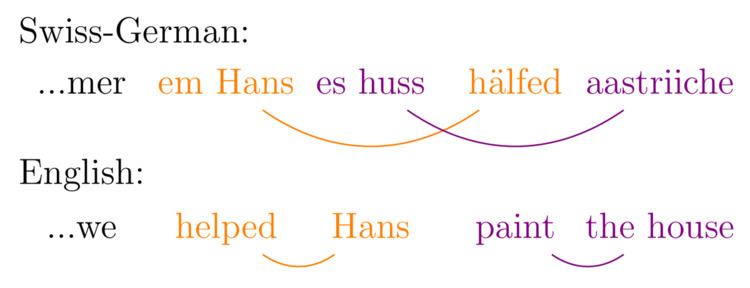 | ||
In linguistics, cross-serial dependencies (also called crossing dependencies by some authors) occur when the lines representing the dependency relations between two series of words cross over each other. They are of particular interest to linguists who wish to determine the syntactic structure of natural language; languages containing an arbitrary number of them are non-context-free. By this fact, Dutch and Swiss-German have been proved to be non-context-free.
Contents
Example
As Swiss-German allows verbs and their arguments to be ordered cross-serially, we have the following example, taken from Shieber:
That is, "we help Hans paint the house."
Notice that the sequential noun phrases em Hans (Hans) and s huus (the house), and the sequential verbs hälfed (help) and aastriiche (paint) both form two separate series of constituents. Notice also that the dative verb hälfed and the accusative verb aastriiche take the dative em Hans and accusative s huus as their arguments, respectively.
Why languages containing cross-serial dependencies are non-context-free
In Swiss-German sentences, the number of verbs of a grammatical case (dative or accusative) must match the number of objects of that case. Additionally, a sentence containing an arbitrary number of such objects is admissible (in principle). Hence, the following formal language is grammatical:
It can be seen that
Treatment
Research in mildly context-sensitive language has attempted to identify a narrower and more computationally tractable subclass of context-sensitive languages that can capture context sensitivity as found in natural languages. For example cross-serial dependencies can be expressed in linear context-free rewriting systems (LCFRS); one can write a LCFRS grammar for {anbncndn | n ≥ 1} for example.
